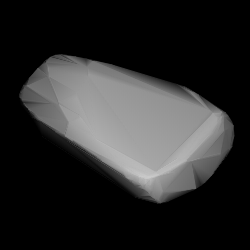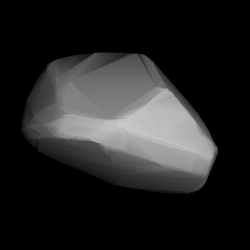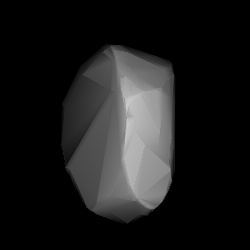Related Research Articles

2830 Greenwich is a bright Phocaea asteroid from the inner regions of the asteroid belt. It was discovered on 14 April 1980, by American astronomer Edward Bowell at Lowell's U.S. Anderson Mesa Station, Arizona, and named for the historical Royal Greenwich Observatory in England. The stony S-type asteroid has a long rotation period of 24 hours and measures approximately 9 kilometers in diameter
2127 Tanya, provisional designation 1971 KB1, is a carbonaceous asteroid from the outer region of the asteroid belt, approximately 40 kilometers in diameter. It was discovered on 29 May 1971, by Russian astronomer Lyudmila Chernykh at the Crimean Astrophysical Observatory in Nauchnij, on the Crimean peninsula. It was named in memory of Tanya Savicheva, a Russian child diarist during World War II.

1130 Skuld, provisional designation 1929 RC, is a stony Florian asteroid from the inner regions of the asteroid belt, approximately 10 kilometers in diameter. It was named after Skuld from Norse mythology.

1069 Planckia, provisional designation 1927 BC, is a background asteroid from the outer regions of the asteroid belt, approximately 39 kilometers in diameter. It was discovered on 28 January 1927, by astronomer Max Wolf at the Heidelberg-Königstuhl State Observatory in Germany. The asteroid was named after German physicist Max Planck.

1042 Amazone, provisional designation 1925 HA, is a dark asteroid and slow rotator in the outer asteroid belt, approximately 70 kilometers in diameter. It was discovered on 22 April 1925, by German astronomer Karl Reinmuth at Heidelberg Observatory in southern Germany. It is named after the Amazons from Greek mythology.
1049 Gotho, provisional designation 1925 RB, is a carbonaceous asteroid from the outer region of the asteroid belt, approximately 53 kilometers in diameter. It was discovered on 14 September 1925, by German astronomer Karl Reinmuth at Heidelberg Observatory in southwest Germany. Although the name of the asteroid is a masculine German name, it is not known to refer to a particular individual.
3567 Alvema, provisional designation 1930 VD, is a dark asteroid from the middle region of the asteroid belt, approximately 14 kilometers in diameter. It was discovered by Belgian astronomer Eugène Delporte at the Royal Observatory of Belgium in Uccle, on 15 November 1930. It was named after the discoverer's three great-granddaughters Aline, Vérionique and Martine.
3724 Annenskij, provisional designation 1979 YN8, is a stony Gefionian asteroid from the central regions of the asteroid belt, approximately 14 kilometers (9 miles) in diameter. It was discovered on 23 December 1979, by Soviet astronomer Lyudmila Zhuravleva at the Crimean Astrophysical Observatory in Nauchnij, on the Crimean peninsula. The S-type asteroid has a rotation period of 3.97 hours. It was named for Russian poet Innokenty Annensky.

3544 Borodino (prov. designation: 1977 RD4) is a stony background asteroid from the inner regions of the asteroid belt, approximately 9 kilometers (5.6 miles) in diameter. It was discovered on 7 September 1977, by Soviet astronomer Nikolai Chernykh at the Crimean Astrophysical Observatory in Nauchnij, on the Crimean peninsula. The likely elongated S-type asteroid has a rotation period of 5.44 hours. It was named for the Russian village of Borodino where the Battle of Borodino took place.
2173 Maresjev, provisional designation 1974 QG1, is a dark background asteroid from the outer regions of the asteroid belt, approximately 28 kilometers (17 miles) in diameter. It was discovered on 22 August 1974, by Soviet–Ukrainian astronomer Lyudmila Zhuravleva at the Crimean Astrophysical Observatory in Nauchnij, on the Crimean peninsula. It was named for Soviet war veteran Alexey Maresyev. The assumed C-type asteroid has a tentative rotation period of 11.6 hours.
3322 Lidiya, provisional designation 1975 XY1, is a stony Phocaea asteroid and potentially slow rotator from the inner regions of the asteroid belt, approximately 7 kilometers in diameter. It was discovered on 1 December 1975, by Soviet astronomer Tamara Smirnova at the Crimean Astrophysical Observatory in Nauchnij, on the Crimean peninsula. The asteroid was named after Russian aviator Lidiya Zvereva.
5430 Luu, provisional designation 1988 JA1, is a stony Phocaea asteroid from the inner regions of the asteroid belt, approximately 7 kilometers in diameter. It was discovered on 12 May 1988, by American astronomer couple Carolyn and Eugene Shoemaker at Palomar Observatory, California, and later named after astronomer Jane Luu.

1175 Margo, provisional designation 1930 UD, is a stony background asteroid from the outermost regions of the asteroid belt, approximately 24 kilometers in diameter. It was discovered on 17 October 1930, by astronomer Karl Reinmuth at the Heidelberg-Königstuhl State Observatory in southwest Germany. The meaning of the asteroids's name is unknown.

4547 Massachusetts is a dark background asteroid from the central regions of the asteroid belt, approximately 24 kilometers in diameter. It was discovered on 16 May 1990, by Japanese astronomers Kin Endate and Kazuro Watanabe at the JCPM Sapporo Station on the island of Hokkaido, Japan. The asteroid was named for the U.S. state of Massachusetts.

1906 Naef is a stony vestoid asteroid from the inner regions of the asteroid belt, approximately 7 kilometers in diameter. It was discovered on 5 September 1972, by Swiss astronomer Paul Wild at Zimmerwald Observatory near Bern, Switzerland. It was later named after Swiss banker and amateur astronomer Robert A. Naef.
For other uses, see Steel (disambiguation).
1266 Tone is a dark background asteroid from the outer regions of the asteroid belt, approximately 80 kilometers in diameter. Discovered by astronomer Okuro Oikawa at the Tokyo Observatory in 1927, it was assigned the provisional designation 1927 BD. The asteroid was later named after the Tone River, one of Japan's largest rivers.

2111 Tselina is a stony Eos asteroid from the outer regions of the asteroid belt. It was discovered on 13 June 1969, by Soviet astronomer Tamara Smirnova at Crimean Astrophysical Observatory in Nauchnij, on the Crimean peninsula. The S-type asteroid has a rotation period of 6.6 hours and measures approximately 23 kilometers in diameter. It was later named after the Soviet Virgin Lands Campaign.
3982 Kastelʹ, provisional designation 1984 JP1, is a Florian asteroid and a suspected binary system from the inner regions of the asteroid belt, approximately 6.9 kilometers in diameter.
(6382) 1988 EL is a stony Hungaria asteroid from the inner regions of the asteroid belt, approximately 5 kilometers in diameter. It was discovered on 14 March 1988, by American astronomer Jeffrey Alu at the U.S. Palomar Observatory, California.
References
- 1 2 3 4 "JPL Small-Body Database Browser: 2004 Lexell (1973 SV2)" (2017-06-03 last obs.). Jet Propulsion Laboratory . Retrieved 29 June 2017.
- 1 2 3 Schmadel, Lutz D. (2007). "(2004) Lexell". Dictionary of Minor Planet Names – (2004) Lexell. Springer Berlin Heidelberg. p. 162. doi:10.1007/978-3-540-29925-7_2005. ISBN 978-3-540-00238-3.
- 1 2 3 4 5 6 "LCDB Data for (2004) Lexell". Asteroid Lightcurve Database (LCDB). Retrieved 29 June 2017.
- 1 2 3 Masiero, Joseph R.; Grav, T.; Mainzer, A. K.; Nugent, C. R.; Bauer, J. M.; Stevenson, R.; et al. (August 2014). "Main-belt Asteroids with WISE/NEOWISE: Near-infrared Albedos". The Astrophysical Journal. 791 (2): 11. arXiv: 1406.6645 . Bibcode:2014ApJ...791..121M. doi:10.1088/0004-637X/791/2/121 . Retrieved 29 June 2017.
- 1 2 3 4 Mainzer, A.; Grav, T.; Masiero, J.; Hand, E.; Bauer, J.; Tholen, D.; et al. (November 2011). "NEOWISE Studies of Spectrophotometrically Classified Asteroids: Preliminary Results". The Astrophysical Journal. 741 (2): 25. arXiv: 1109.6407 . Bibcode:2011ApJ...741...90M. doi:10.1088/0004-637X/741/2/90.
- 1 2 3 4 5 Vander Haagen, Gary A. (October 2010). "Lightcurve and H-G Parameters for 2004 Lexell". The Minor Planet Bulletin. 37 (4): 137–138. Bibcode:2010MPBu...37..137V. ISSN 1052-8091 . Retrieved 29 June 2017.
- 1 2 Behrend, Raoul. "Asteroids and comets rotation curves – (2004) Lexell". Geneva Observatory . Retrieved 29 June 2017.
- 1 2 Albers, Kenda; Kragh, Katherine; Monnier, Adam; Pligge, Zachary; Stolze, Kellen; West, Josh; et al. (October 2010). "Asteroid Lightcurve Analysis at the Oakley Southern Sky Observatory: 2009 October thru 2010 April". The Minor Planet Bulletin. 37 (4): 152–158. Bibcode:2010MPBu...37..152A. ISSN 1052-8091 . Retrieved 29 June 2017.
- 1 2 3 Veres, Peter; Jedicke, Robert; Fitzsimmons, Alan; Denneau, Larry; Granvik, Mikael; Bolin, Bryce; et al. (November 2015). "Absolute magnitudes and slope parameters for 250,000 asteroids observed by Pan-STARRS PS1 - Preliminary results". Icarus. 261: 34–47. arXiv: 1506.00762 . Bibcode:2015Icar..261...34V. doi:10.1016/j.icarus.2015.08.007 . Retrieved 29 June 2017.
- 1 2 "2004 Lexell (1973 SV2)". Minor Planet Center. Retrieved 29 June 2017.
- ↑ Schmadel, Lutz D. "Appendix – Publication Dates of the MPCs". Dictionary of Minor Planet Names – Addendum to Fifth Edition (2006–2008). Springer Berlin Heidelberg. p. 221. doi:10.1007/978-3-642-01965-4. ISBN 978-3-642-01964-7.